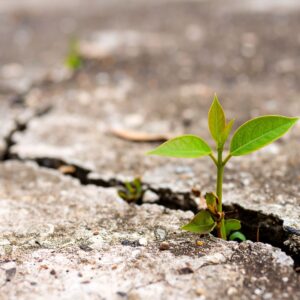I live near Seattle, one of the first places in the US that COVID-19 hit hard. The first time I went to the grocery store after we all started to get a sense of the magnitude of this crisis, I took pictures of empty shelves where rice, flour, and chicken had been, as if I needed some kind of proof that this threat that had seemed so improbable just days before was real. My brain couldn’t wrap around this as the new normal.
As each new order rolled out—school closure order, social distancing order, stay at home order—I felt more disoriented, less able to predict what would await me tomorrow. As this crisis continues, my breathing is more shallow, my heartbeat is faster, and my ability to concentrate is compromised. My feelings are big and my fears are bigger.
I am experiencing the signs of trauma–and you probably are, too.
Our world is in the midst of a collective trauma.
Trauma is not too strong a word to use for our shared experience, as the mechanics of trauma are not so much in the specifics of the traumatizing event as they are in the way that event impacts us. For some, the source of traumatic impact is an observable loss. Some of us have lost jobs and some of us have lost loved ones. For others, the source of trauma is chronic stress. Consider the increase of both types of stress and intensity of stress that people are experiencing:
- Financial strain
- Isolation
- Crisis-schooling children while trying to work
- Fear about our own health and the health of those we love
- Marital stress
- Job insecurity
- Unpredictability of daily life
- Scarcity (or perceived scarcity) of everyday supplies
- Worldviews upended
- Feeling helpless
Exacerbating it all is that there is no real end in sight, no way to pace ourselves so we have enough—enough energy, time, money and sanity—to make it across a finish line. It’s not a sprint; it’s not even a marathon. It’s chronic.
Right now, the pandemic is causing the kind of chronic stress that exhausts us with its waves of fight or flight hormones and traumatizes us collectively and as individuals.
Understanding complex trauma
In his 2016 dissertation, Randolph Kanipe posited that the cumulative effect of chronic stress may lead to the symptoms of a kind of trauma called complex trauma.
Complex trauma refers to the “hyper-sensitive or hyper-reactive response in individuals that have experienced extended periods of stress, threats, and anxiety and leads to the development of Posttraumatic Stress Syndrome within affected individuals.” Randolph Wayne Kanipe, “Clergy, Stress, Complex Trauma and Sabbath Practice”
In other words, the chronic stress of life during the COVID-19 crisis may be amplifying your feelings and impacting your body by running your nervous system on high alert. If not mitigated, a nervous system running on high alert for extended periods of time can change the brain such that the person remains reactive and hyper-vigilant, even when the crisis period passes.
While it might not be comfortable to hear that you may be experiencing complex trauma, knowing that there is an explanation for why you feel strung out and exhausted all the time can be a relief. This knowledge can also equip you to know what to do to mitigate the long-term effects of chronic stress.
Strategies for moving through trauma
Two strategies that I’m trying to use to tamp down my own over-stressed system are explained below.
“Completing” the stress cycle
Stress is a biochemical response that is meant to protect us in times of threat. As such, it is supposed to have a beginning (the threat appears!), a middle (a flood of fight or flight hormones), and an end (physical activity that uses up those stress hormones). In chronic stress, there is no natural “end” to the cycle. Instead, you have to intentionally find ways to bring down the levels of stress hormones, even if you know they are going to rise back up again.
Classic recommendations for completing the stress cycle are exercise, sleep, and physical comfort, like a hug. If you have the ability to do those things, you should! But if being time-starved or physically isolated is part of the problem, there are still things you can do. Connecting with friends, any way that you can, reduces stress. Five minutes of breathing exercises or mindful meditation will noticeably calm your body. My personal favorite way of completing the stress cycle these days? Letting the tears fall.
At the start of a recent meeting—a Zoom meeting, of course—my boss made space for each of us to share how we were doing in the midst of this crisis. Several people, myself included, noted that they were unusually teary. Just having this conversation gave me permission to let the tears behind my eyes roll down my cheeks. And within a few minutes, I felt a bit better.
Letting the tears out provides a kind of “release value” “The Health Benefits of Tears,” Psychology Today to counter the pressure of chronic stress. Emotional tears literally rinse some of the stress hormones out of your body. Really. There is cortisol in your tears.
A 2019 research study found that crying may help the body to maintain “biological homeostasis” via breathing patterns and heart rate. “Using crying to cope: Physiological responses to stress following tears of sadness.
If you are crying multiple times a day, you may want to reach out to a mental health professional. But it’s expected that in times like these, when chronic stress reaches the level of trauma, you may need the occasional release of tears.
Practice self-compassion
Self-compassion means valuing yourself based on your innate worth as a human being, not for what you do. Self-compassion means being kind to yourself instead of judgmental when you make mistakes. It means being mindful and accepting of your own thoughts and feelings, and seeing your experiences, good and bad, as a part of being human. Thank you to Doug Shirley for introducing me to the concept of self-compassion.
Self-compassion, at its most basic, means giving yourself permission to be human.
In the midst of chronic stress, being human looks like letting your needs be known. It looks like being behind at work while also feeling guilty for inattentive parenting. It looks like sacrificing for the greater good—and snapping at your roommate. It means you can throw up your hands and say “there is no fixing this situation and no perfect person behind this face” and still know you are infinitely valuable.
Noticing and accepting my thoughts and feelings sounds cheesy to me—until it’s really helpful, like when I was trying to get some exercise with my kids and one of them was sassy. In my chronically stressed state, I sarcastically thought “I would like to push him off his ever-loving bike.” Did I do that? Of course not. But by non-judgmentally noticing the thought, I saw my need to release stress and could make a plan to do so, a plan that involved asking my spouse to listen to my frustration as well as trading ambitions of doing yard work with the kids for the stress-releasing (but low-status) activity of cuddling with them while watching an episode of LegoMasters.
Practicing resilience
In times of chronic stress, perhaps especially in a traumatic era, it’s increasingly important to intentionally develop our wellbeing and resilience. Completing stress cycles and practicing self-compassion can help reduce the effects of stress now and, in the long term, protect your brain from developing patterns of hypervigilance.
Other ways to develop resilience include engaging your community of support, developing practices, or leaning into your purpose as it adapts to this new context.










0 Comments